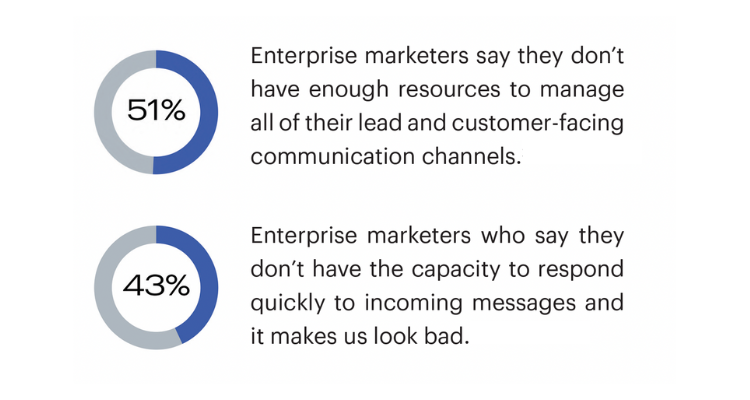Incorporating texting with customers as a small business can be daunting. But you don’t want to let that stop you from using texting. It will dramatically improve your communications with customers—and, it’s the communication platform they prefer.
To make the task of incorporating customer texting easier, we’ve gathered the essential steps to follow as you choose a messaging platform featuring texting. With the help of this guide, you will have the latest data at your fingertips and be ready to take action.
1. Determine Who Is Responsible for the Decision
In every organization, there should be a single person or team that has ownership over the customer journey. They are in charge of overseeing all customer experiences and paying attention to quality and experience. When choosing this person or team, keep in mind that their department doesn’t matter as much as their ability to understand and meet your customers’ communication needs.
This person or team also has to understand that every channel requires a slightly different approach. For example, people expect very different language and tone in a text than in an email. More importantly, people expect to receive a very fast response to a text but not all other forms of communication.
Impressively, 90% of texts get read in just three minutes. If you don’t live up to these high expectations, your customers will feel slighted.

2. Decide Which Channels Are Relevant
Next, figure out which channels are relevant—where do your customers want to communicate with you? This is essential for the customer experience. Consider that 96% of marketers say customers prioritize receiving a fast response, yet only 53% of marketers offer more than phone and email—both of which are associated with a slow response time.
So, how do you figure out which channels are relevant?
- Determine your goals: Consider how important a fast response is to customers, if certain types of communication require more urgency, and where in the journey customers leave.
- Understand the channels your customers prefer: Don’t just assume that you know which channels your customers prefer to communicate on. For urgent communication, for example, Twilio found customers are twice as likely to prefer texts from a business over emails.
- Recognize what you can manage well: Take the time to figure out what you can realistically manage well and what you can’t. Always opt for a few well-managed points of contact over a lot of poorly-managed ones. Interactions become less personal if there are too many points of contact.
3. Plan to Leverage Texting
Recent Twilio research found that 66% of consumers prefer reaching brands through messaging. Around 85% want to be able to answer and receive messages from brands via text. Despite this, only 48% of enterprise companies offer texting to interact with customers.
If you aren’t convinced that you need to leverage texting, consider the following:
- 90% of texts are read within three minutes
- 78% of consumers say texting is the fastest method of reaching them
- 81% of consumers feel frustrated waiting for customer service on the phone
- 86% of American consumers opt into text notifications from companies
- In the last decade, monthly texts have increased by 7,700%
- The average American checks their phone 150 times a day
4. Consolidate Channels Into a Single Inbox
You know what channels you need to offer in addition to texting. Now you need to get them all into a single inbox. With the right tools on your side, responding to customers in a timely manner is easy.
Be cautious with this, however. Not all communication tools are created equal. You don’t want messages from different channels handled differently by your chosen program. That can lead to frustration for both your team and your customers. It can also eliminate transparency and oversight.
But why do you want to consolidate your channels? Having to switch between communication channels reduces productivity and wastes time. Consolidating your communication channels will help save precious time on your end and improve the customer experience as a result.
5. Provide the Necessary Tools
We’ve established that offering texting is crucial for your business. But there is one important caveat—don’t expect your employees to use their personal phones or numbers. Salespeople do this to show their commitment, but it can be dangerous. Our research shows that a surprising 39% of surveyed companies are using personal phone numbers when connecting with customers.
But the risks are twofold; you risk customer privacy and company assets.
→Customer Privacy Risks
You have a privacy policy, and it likely says that contact information has to be kept private. But how is this possible if the contact information is on your team’s personal devices? On top of that, your company probably can’t access your team’s devices.
→Company Asset Risks
Conversations and agreements are company assets. If your company can’t view these, you hurt the customer experience. But you also leave yourself open to potential liability.
Avoid those risks by providing the right tools, including a device to communicate with clients and a phone number for doing so.
6. Staff Appropriately
Even if you have the right systems and tools in place, that doesn’t automatically mean that your text interactions will go off without a hitch. Having the right team will make a significant difference. While having messages from all channels in a single place helps, it can’t compensate for a poorly qualified team or not having a large enough team.
Staffing is a big struggle for many companies, with 51% saying they don’t have enough resources to manage all customer-facing communication and lead channels. Of those who say they don’t have enough capacity, 43% say that the fact that they can’t respond quickly to messages makes them look bad.

The ideal solution is to have a dedicated team for customer-facing communications.
7. Train Your Team
Once you have the right team in place, it is time to make sure they have the necessary skills and training to prioritize responsiveness and deliver a good customer experience. Excellent training is what separates the most-loved brands from those that customers hate interacting with.

According to our research, when marketers were asked what they feel is most important to customers and leads, the results were as follows:
- 96% said receiving a fast response
- 91% speaking to a real person
- 87% said using whatever communication channel they prefer
- 84% said being able to communicate outside of business hours
You can easily turn those four answers into key training points and goals. Add in that almost 80% of customers say that the most important factors for a good customer experience are speed, knowledgeable help, friendly service, and convenience. And that 75% of consumers have rewarded companies that communicate how they prefer.
Conclusion—What Now?
Incorporating texting into your customer-facing communication strategy doesn’t have to be daunting. With the above steps, you should be well on your way to creating and executing a solid strategy. If you still aren’t sure whether texting is right for your business, consider that 90% of consumers say it is their preferred communication method.
Podium is not just an interaction management platform. It is the only one that lets you use texting to keep up with customer expectations, stand out, and offer modern, convenient experiences. Talk to one of our Podium product specialists to start using text communications with customers and doing so on a platform that lets you access all channels from a single inbox.



